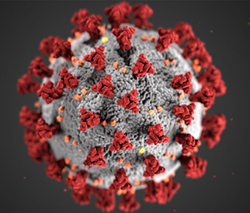Neuroscience For Kids
Smell and the COVID-19 Pandemic
By Demetria Dickinson (Neuroscience for Kids Guest Writer)
[Edited by Ellen Kuwana, MS]
Smell Basics
Olfactory (ol-FAC-to-ry) cells are the cells in your body that detect chemicals in the air and let you smell the scents around you. These cells are located in the top of the inside of the nose, so that they can catch molecules when you breathe in. Their full name is olfactory neurons. These cells carry smell information to cells in the brain. The brain interprets this information and tells you what you're smelling.
For more basics on smells and the cells in the nose, see The Nose Knows.
COVID-19 Symptoms

COVID-19 is a respiratory illness caused by the virus called SARS-CoV-2 (see picture to the right). Respiratory means that the illness affects a person's breathing. During the COVID-19 pandemic, many people lost their sense of smell. This strange symptom is one of the main signs of this new illness.
At first, many doctors and nurses didn't realize that smell loss was a symptom of COVID-19. Respiratory infections such as COVID-19 affect the lungs, nose, and throat. But these infections usually don't affect olfactory neurons or the cells in the brain that receive their information. With other respiratory illnesses, sometimes people lose the sense of smell for a short time because the inside of the nose gets swollen and people aren't able to smell as well as they usually do because of their stuffed-up nose.
Then lots of people began talking about losing their smell, right before a test showed they had COVID-19. Many of them did not have any other symptoms. Because of this, scientists were concerned that this new virus was attacking the olfactory neurons or the brain itself. This would cause a loss of smell without other symptoms.
Scientists quickly got to work to find some answers. Researchers at Harvard University found that this new virus that causes COVID-19 can't infect olfactory neurons. The virus actually attacks the support cells around these neurons. These support cells give the neurons food, physical support, and the ability to regrow if they're damaged. When these support cells are damaged or killed by the virus, they can't take care of the neurons. As a result, olfactory neurons can't send information about smells to the brain. Also, without the support cells, sometimes these neurons die.

Image source: CDC (October 18, 2021)
Anosmia and Hyposmia
Anosmia (an-OS-mee-a) means that a person has no sense of smell. It comes from "an" (without) + "osme" (smell).
Hyposmia (hi-POS-mee-a) means that a person has a limited or reduced sense of smell. It comes from "hypo" (under, less than) + "osme" (smell). People with hyposmia can only detect strong smells.
You might not think that smell is an important sense. Smell, though, is very important for our enjoyment of life. It helps us to taste, to interpret our surroundings, and to detect dangers such as spoiled food or smoke from a fire. When people with COVID-19 lost their sense of smell, they said they felt alone and distant from their environment.
Recovery and Parosmia
About 95% of patients with anosmia and hyposmia got their smell back within 6 months after they had COVID-19. After many people recovered their sense of smell, they felt as if something was wrong or "off" with their sense of smell. This is known as parosmia (par-OS-mee-a), from "para" (beside, beyond, abnormal) + "osme" (smell). For these people, their brain interpreted smells wrong. They said that food smelled like gasoline. For those who had COVID-19 and lost their sense of smell, parosmia often started about 3 months later.
Sometimes the nose can smell something that isn't there at all. This is called phantosmia (fant-OS-mee-a) or phantom smells. Scientists think that parosmia and phantosmia might happen because the olfactory neurons get connected wrong when they grow back after being damaged by the virus. These conditions usually go away as the neurons heal.
Long COVID
Some people are affected by COVID-19 for months instead of weeks. This is known as "long COVID." It affects about 1 in 3 people with COVID-19 symptoms. Patients are more likely to have long COVID if they had to be in the hospital. Several studies showed that over 75% of hospitalized patients were still feeling COVID-19 effects months after the initial sickness.
These long-term symptoms include anosmia and its related conditions. Some people don't get their sense of smell back, even after they recover from the other symptoms of COVID-19. Losing one's sense of smell can lead to depression and feeling isolated and disconnected from the world. It can also lead to danger. People with anosmia can't tell if food is spoiled or something is burning.
There might be other, longer-term neurological effects from COVID-19 and it will take time for the full effects to be discovered.
More Facts
- Smell loss is the best way to tell a mild COVID-19 infection from other respiratory infections before getting tested. Surveys about smell loss can predict waves and peaks of the COVID-19 pandemic.
- Loss of smell is also a possible symptom of neurological diseases such as Alzheimer's disease, Parkinson's disease, schizophrenia, and depression.
- Some people are born with anosmia. Because babies are not given smell tests (they do get tested for eyesight and hearing), most people born without the ability to smell don't realize it until they're teenagers.
Selected References
- Jarvis, B. (2021, January 28). What can COVID-19 teach us about the mysteries of smell?, The New York Times.
- Jiang, K. (2020). How COVID-19 causes loss of smell, Harvard Medical School News & Research.
- LaVergne, S. (2021, February 17). How many people get "long COVID" and who is most at risk?, The Conversation.
- Schive, K. (2021). It's been months since I had COVID-19; when will my smell and taste return?, MIT Medical.
Copyright © 1996-2021, Eric H. Chudler All Rights Reserved.
